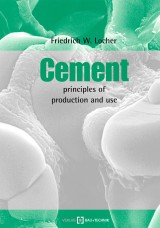Details
Cement
principles of production and use1. Aufl.
|
89,99 € |
|
| Verlag: | Verlag Bau+Technik |
| Format: | EPUB |
| Veröffentl.: | 20.03.2013 |
| ISBN/EAN: | 9783764005368 |
| Sprache: | englisch |
| Anzahl Seiten: | 536 |
Dieses eBook enthält ein Wasserzeichen.
Beschreibungen
The successful launch of the German standard work on cement by Prof. Locher in 2000 is now being followed by the publication of the widely requested English language version "Cement" which takes special country-specific features and standards into account.
The book is aimed at chemists, physicists, engineers and technologists in the cement industry, in machine construction, the construction industry, materials testing and environmental protection. This clear and practical book will provide them with the understanding of the chemistry of cement needed for their daily work. It will also make an ideal textbook for the study of building materials science at colleges and universities.
The book is aimed at chemists, physicists, engineers and technologists in the cement industry, in machine construction, the construction industry, materials testing and environmental protection. This clear and practical book will provide them with the understanding of the chemistry of cement needed for their daily work. It will also make an ideal textbook for the study of building materials science at colleges and universities.
1 Classification of cements
1.1 Definition
1.2 European and German standard cements
1.3 Cements covered by the ASTM standards
2 History of cement
2.1 The material basis of hydraulic binders
2.2 Burning the cement clinker
2.3 Comminution of raw materials and cement
2.4 Environmental protection
2.5 Glassy blastfurnace slag
2.6 Cements with special properties
2.7 Cement standards
3 Cement clinker
3.1 Composition of cement clinker
3.2 Production of cement clinker
3.3 Assessing the cement clinker
4 Other main constituents
4.1 General survey
4.2 Granulated blastfurnace slag
4.3 Burnt shale (oil shale)
4.4 Natural pozzolanas
4.5 Synthetic pozzolanas
4.6 Limestone
5 Grinding the cement
5.1 Grinding processes
5.2 Fineness, particle size distribution
5.3 Grindability
5.4 Grinding aids
6 Environmental protection during the manufacture of cement
6.1 General review
6.2 Dust
6.3 Vaporizable constituents, recirculating systems, balances,
emission and immission
6.4 Gases
7 Cement hardening
7.1 Introduction
7.2 Hydration products
7.3 Hydration reactions
8 Constitution and properties of hardened cement paste
8.1 Water bonding
8.2 Specific surface area and particle size of the hydration products
8.3 Microstructure
8.4 Porosity
8.5 Strength
8.6 Deformation
8.7 Permeability
8.8 Effect on metals, corrosion protection
8.9 Resistance to chemical attack
8.10 Alkali-aggregate reaction
8.11 Freeze-thaw resistance
9 Standard cements with special properties, special cements
9.1 General review
9.2 Cement with high sulfate resistance
9.3 Cement with low heat of hydration
9.4 Cement with low effective alkali content
9.5 Regulated set cement (Quick-hardening cement)
9.6 Expansive cement
9.7 Oil well cement
9.8 Hydrophobic cement
9.9 Ultrafine binders
9.10 Cement for sprayed concrete
9.11 Masonry cement
9.12 Supersulfated cement
9.13 High-alumina cement
10 Environmental compatibility of cement and concrete
10.1 Cement dust
10.2 Alkaline action
10.3 Action of chromate
10.4 Fixation of environmentally relevant substances with cement
10.5 Radioactivity and concrete
11 Literature
12 Index
13 Chemical Formulae
1.1 Definition
1.2 European and German standard cements
1.3 Cements covered by the ASTM standards
2 History of cement
2.1 The material basis of hydraulic binders
2.2 Burning the cement clinker
2.3 Comminution of raw materials and cement
2.4 Environmental protection
2.5 Glassy blastfurnace slag
2.6 Cements with special properties
2.7 Cement standards
3 Cement clinker
3.1 Composition of cement clinker
3.2 Production of cement clinker
3.3 Assessing the cement clinker
4 Other main constituents
4.1 General survey
4.2 Granulated blastfurnace slag
4.3 Burnt shale (oil shale)
4.4 Natural pozzolanas
4.5 Synthetic pozzolanas
4.6 Limestone
5 Grinding the cement
5.1 Grinding processes
5.2 Fineness, particle size distribution
5.3 Grindability
5.4 Grinding aids
6 Environmental protection during the manufacture of cement
6.1 General review
6.2 Dust
6.3 Vaporizable constituents, recirculating systems, balances,
emission and immission
6.4 Gases
7 Cement hardening
7.1 Introduction
7.2 Hydration products
7.3 Hydration reactions
8 Constitution and properties of hardened cement paste
8.1 Water bonding
8.2 Specific surface area and particle size of the hydration products
8.3 Microstructure
8.4 Porosity
8.5 Strength
8.6 Deformation
8.7 Permeability
8.8 Effect on metals, corrosion protection
8.9 Resistance to chemical attack
8.10 Alkali-aggregate reaction
8.11 Freeze-thaw resistance
9 Standard cements with special properties, special cements
9.1 General review
9.2 Cement with high sulfate resistance
9.3 Cement with low heat of hydration
9.4 Cement with low effective alkali content
9.5 Regulated set cement (Quick-hardening cement)
9.6 Expansive cement
9.7 Oil well cement
9.8 Hydrophobic cement
9.9 Ultrafine binders
9.10 Cement for sprayed concrete
9.11 Masonry cement
9.12 Supersulfated cement
9.13 High-alumina cement
10 Environmental compatibility of cement and concrete
10.1 Cement dust
10.2 Alkaline action
10.3 Action of chromate
10.4 Fixation of environmentally relevant substances with cement
10.5 Radioactivity and concrete
11 Literature
12 Index
13 Chemical Formulae
Prof. Locher worked for 35 years at the German Research Institute of the Cement Industry as head of the cement chemistry and cement technology department and member of the management of the German Cement Works Association.



















